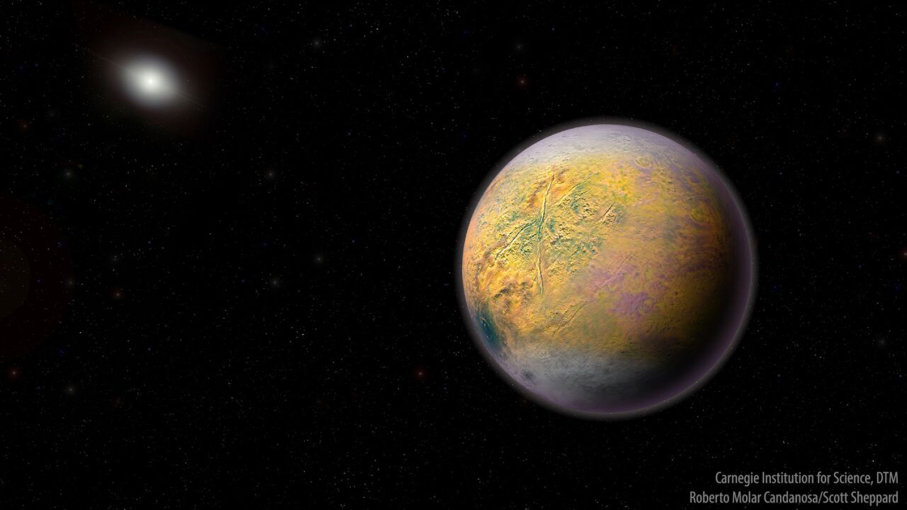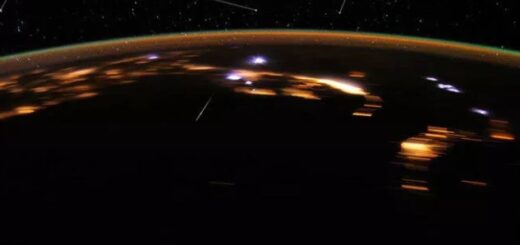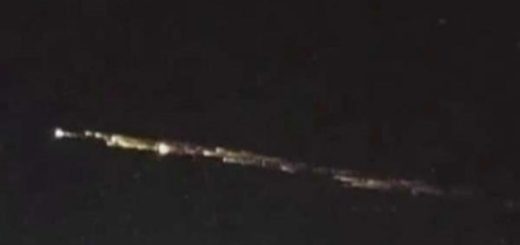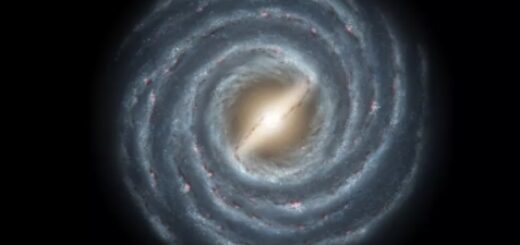‘The Goblin’ May Reveal the Phantom of Planet X Lurking in Deep Space

Artist’s conception of the long-sought-after distant solar system Planet X (aka Planet Nine), which could be shaping the orbits of smaller extremely distant outer solar system objects like 2015 TG387 (aka “The Goblin”) ROBERTO MOLAR CANDANOSA AND SCOTT SHEPPARD, COURTESY OF CARNEGIE INSTITUTION FOR SCIENCE
Deep in the most distant reaches of the solar system, astronomers have discovered a small world with an astonishingly long orbit around our sun. The world has been nicknamed “The Goblin,” and its discovery could lead us to find another, more monstrous world that’s steeped in mystery and intrigue: the fabled Planet X.
The discovery of The Goblin, a small dwarf planet officially called 2015 TG387, has been tracked by telescopes since 2015, and astronomers have now determined just how extreme its orbit is. It’s currently located about 80 AU from the sun (where one AU, or astronomical unit, is the average distance at which Earth orbits the sun) — or nearly 2.5 times farther away than Pluto. At the farthest point in its highly elongated 40,000-year orbit, TG387 reaches a whopping 2,300 AU (over 200 billion miles or over 340 billion kilometers) away.
“We think there could be thousands of small bodies like 2015 TG387 out on the solar system’s fringes, but their distance makes finding them very difficult,” said David Tholen, of the University of Hawaii and co-investigator of the new study submitted for publication in The Astronomical Journal. “Currently we would only detect 2015 TG387 when it is near its closest approach to the sun. For some 99 percent of its 40,000-year orbit, it would be too faint to see.”
A handful of objects like TG387 are known, and they are thought to be a part of a population of icy worlds that populate the Inner Oort Cloud. However, TG387 has the most extreme orbit that doesn’t take it anywhere near the gravities of the planets of the solar system. In other words, its orbit isn’t influenced by planets like massive Jupiter.
But it appears the 300-kilometer (186-mile) wide dwarf planet isn’t immune from being pushed around. Something is out there, in the dark, mysteriously shepherding The Goblin’s sluggish stroll around the sun.
Enter Planet X
For many years, planet-hunting astronomers have been searching for something large lurking in deep space — a hypothetical planet that could be 10 times the mass of Earth and approximately the size of the ice giants Uranus or Neptune. The problem is that it orbits so far away that it’s extremely hard to find in the vast expanse of space, but a planet of that size should leave some forensic evidence of its presence in the gravity it exerts on other objects in its deep space domain.
In January 2015, Caltech astronomers Konstantin Batygin and Mike Brown announced that they had found that evidence imprinted in the orbits of five small objects in the distant hinterlands of our planetary system. These objects are apparently being corralled, like cattle being guided toward an enclosure, by an unknown gravitational force independent from the known planets that orbit the sun.
This gravitational corralling could be the evidence for Planet X – called unofficially “Planet 9” by Batygin and Brown – that astronomers have been looking for all along. And the discovery of TG387 has reinforced this theory.
“These distant objects are like breadcrumbs leading us to Planet X. The more of them we can find, the better we can understand the outer solar system and the possible planet that we think is shaping their orbits – a discovery that would redefine our knowledge of the solar system’s evolution,” said study co-author Scott Sheppard, of the Carnegie Institution for Science, in a statement.
After collecting years of observational data, the researchers ran computer simulations for how different Planet X orbits would impact the motion of TG387. One simulation showed that a large, super-Earth-like planet with a highly eccentric (elongated) orbit at a distance of several hundred AU could be the phantom culprit, a scenario that closely resembles the hypothetical orbit of Batygin and Brown’s Planet Nine.
A comparison of 2015 TG387 at 65 AU with the solar system’s known planets.
A comparison of 2015 TG387 at 65 AU with the solar system’s known planets. Saturn can be seen at 10 AU and Earth is, of course, at 1 AU, as the measurement is defined as the distance between the sun and our home planet.
ROBERTO MOLAR CANDANOSA AND SCOTT SHEPPARD, COURTESY OF CARNEGIE INSTITUTION FOR SCIENCE
Interestingly, this gravitational shepherding has forced this group of small objects into similar, stable orbits that keep them far enough away from the hypothetical planet’s orbit. According to the researchers, this is similar to Pluto; although the dwarf planet crosses Neptune’s orbit, Pluto keeps a healthy distance from Neptune to avoid a collision or being flung out of its stable orbit.
“What makes this result really interesting is that Planet X seems to affect 2015 TG387 the same way as all the other extremely distant solar system objects. These simulations do not prove that there’s another massive planet in our solar system, but they are further evidence that something big could be out there,” said researcher Chad Trujillo, of Northern Arizona University.
Planet X: A Long History
The search for Planet X is steeped in a rich history of scientific curiosity. Originally, the hunt for Planet X was centered around the search for what turned out to be Pluto. In fact, the story begins a little before that.
In 1843, British astronomer John Couch Adams studied the orbital perturbations of Uranus and calculated that the gravity of another, undiscovered planet must be the culprit. Sure enough, this was the forensic evidence of gravitational interference that led to the discovery of Neptune. This method of planetary discovery has been used on multiple occasions and, over time, astronomers reported strange perturbations in Neptune’s orbit, inspiring astronomers to hunt down a mysterious world that was nicknamed Planet X.
Illustration of Planet Nine
This is the image HowStuffWorks first came up with when Caltech astronomers announced they’d found evidence of Planet Nine, aka Planet X.
CALTECH/R. HURT/HOWSTUFFWORKS
In 1930, after painstakingly surveying astronomical plates, astronomer Clyde Tombaugh discovered a planet and it was assumed that the hunt for Planet X was complete. Planet X was Pluto!
Alas, as the years went on, astronomers realized that Pluto was too tiny to explain perturbations in any large planet’s orbit. In fact, Pluto was deemed so tiny that it was demoted (controversially) from its planetary status in 2006, creating a whole new subclass of dwarf planets. So, although the search for Planet X resulted in the discovery of Pluto, it wasn’t the Planet X astronomers were hoping for.
Other clues to the presence of a massive planet in the outer realms of the solar system have since come to light, including strange features in the Kuiper Belt (a region around Pluto’s orbit that contains countless tiny worlds that are greatly influenced by the gravities of the solar system’s planets), but the strongest clues are now coming from even farther afield, far past Pluto and the Kuiper Belt and into a region that pushes the limits of our observational abilities.



 Creators of mankind
Creators of mankind Description of “Tall white aliens”
Description of “Tall white aliens” Where they came from?
Where they came from? About hostile civilizations
About hostile civilizations The war for the Earth
The war for the Earth “Tall white aliens” about eternal life
“Tall white aliens” about eternal life Video: “Nordic aliens”
Video: “Nordic aliens” Aliens
Aliens Alien encounters
Alien encounters The aliens base
The aliens base UFO
UFO Technology UFO
Technology UFO Underground civilization
Underground civilization Ancient alien artifacts
Ancient alien artifacts Military and UFO
Military and UFO Mysteries and hypotheses
Mysteries and hypotheses Scientific facts
Scientific facts


















